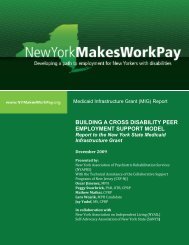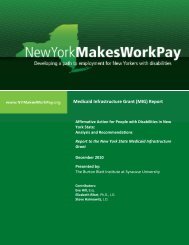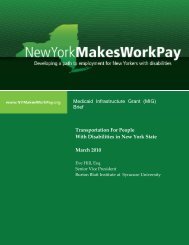Disability & Employment Law in New York State - Cornell University
Disability & Employment Law in New York State - Cornell University
Disability & Employment Law in New York State - Cornell University
You also want an ePaper? Increase the reach of your titles
YUMPU automatically turns print PDFs into web optimized ePapers that Google loves.
<strong>Disability</strong> & <strong>Employment</strong> <strong>Law</strong> <strong>in</strong> <strong>New</strong> <strong>York</strong> <strong>State</strong>:Analysis and Recommendationsuses pairs of applicants with match<strong>in</strong>g qualifications but differ<strong>in</strong>g racial or gendercharacteristics, <strong>in</strong> order to determ<strong>in</strong>e whether employers are less likely to hire based ona demographic difference. Because employers generally do not give applicants withdisabilities a reason for not hir<strong>in</strong>g them, discrim<strong>in</strong>ation <strong>in</strong> hir<strong>in</strong>g is very difficult to prove.Therefore, test<strong>in</strong>g programs like these are essential to identify and prove discrim<strong>in</strong>ation<strong>in</strong> hir<strong>in</strong>g of people with disabilities. <strong>Disability</strong> rights test<strong>in</strong>g programs have successfullybeen conducted <strong>in</strong> the context of hous<strong>in</strong>g. 165Like the ADA, but unlike the state law, the <strong>New</strong> <strong>York</strong> City <strong>Law</strong> allows for recovery ofattorney’s fees. 166 Like the state law, it allows for unlimited recovery of compensatorydamages, but unlike the state law, it also provides for punitive damages. 167 Unlike theADA, the City <strong>Law</strong> does not place any caps on recovery of compensatory or punitivedamages. The City <strong>Law</strong> also provides for civil penalties up to $125,000 as needed <strong>in</strong> thepublic <strong>in</strong>terest, or up to $250,000 for willful, wanton, or malicious discrim<strong>in</strong>ation. 168V Comparisons and VariationsNumerous states share with <strong>New</strong> <strong>York</strong> a commitment to a more expansive def<strong>in</strong>ition ofdisability than the standard of a “substantial limitation of a major life activity” posited <strong>in</strong>the ADA. M<strong>in</strong>nesota, for <strong>in</strong>stance, def<strong>in</strong>es disabilities as conditions which “materiallylimit” a “major life activity.” 169 Like the ADA requires that an impairment affect a “major”life activity. However, the “materially limit” standard is less str<strong>in</strong>gent than the ADA, 170mak<strong>in</strong>g it, <strong>in</strong> practice, more comparable to the <strong>New</strong> <strong>York</strong> standard. Similarly, theCalifornia Fair <strong>Employment</strong> and Hous<strong>in</strong>g Act, 171 is significantly more expansive than thedef<strong>in</strong>ition <strong>in</strong> the ADA, as it elim<strong>in</strong>ates the standard of a “substantial” limitation, focus<strong>in</strong>g<strong>in</strong>stead on whether discrim<strong>in</strong>ation is occurr<strong>in</strong>g, and/or reasonable accommodationsexist and have been provided. 172 In addition, an alternate state statutory model, asembodied <strong>in</strong> the Ma<strong>in</strong>e Human Rights Act, comb<strong>in</strong>es a broad def<strong>in</strong>ition of disabilitycomparable to the ADA (<strong>in</strong>volv<strong>in</strong>g a substantial limitation standard), with an additionalcategory of coverage based on a per se list of specific disabilities which enjoyprotection, regardless of the severity. 173While <strong>New</strong> <strong>York</strong> is among the states provid<strong>in</strong>g wider coverage <strong>in</strong> terms of its def<strong>in</strong>itionof disability, some state statutes go further <strong>in</strong> protect<strong>in</strong>g <strong>in</strong>dividuals with disabilities, <strong>in</strong>165 Fair Hous<strong>in</strong>g Institute, http://www.fairhouse.net/library/article.php?id=35.166 <strong>New</strong> <strong>York</strong> City Adm<strong>in</strong>istration Code § 8-502(f).167 Id. § 8-502(a).168 Id. §8-126.169 See M<strong>in</strong>n. Stat. § 363A.03(12).170 See Kammueller v. Loomis, Fargo & Co., 383 F.3d 779 ( 8th Cir. 2004).171 See Cal. Gov’t Code §§ 12900-12996 (2003).172 See Colmenares v. Braemar Country Club, Inc., 29 Cal.4th 1019 (2003).173 Ma<strong>in</strong>e Revised Statutes Tit. 5, Ch. 337, § 4553-A (“absent, artificial or replacement limbs, hands, feetor vital organs; alcoholism; amyotrophic lateral sclerosis; bipolar disorder; bl<strong>in</strong>dness or abnormal visionloss; cancer; cerebral palsy; chronic obstructive pulmonary disease; Crohn's disease; cystic fibrosis;deafness or abnormal hear<strong>in</strong>g loss; diabetes; substantial disfigurement; epilepsy; heart disease; HIV orAIDS; kidney or renal diseases; lupus; major depressive disorder; mastectomy; mental retardation;multiple sclerosis; muscular dystrophy; paralysis; Park<strong>in</strong>son's disease; pervasive developmentaldisorders; rheumatoid arthritis; schizophrenia; and acquired bra<strong>in</strong> <strong>in</strong>jury”).24





